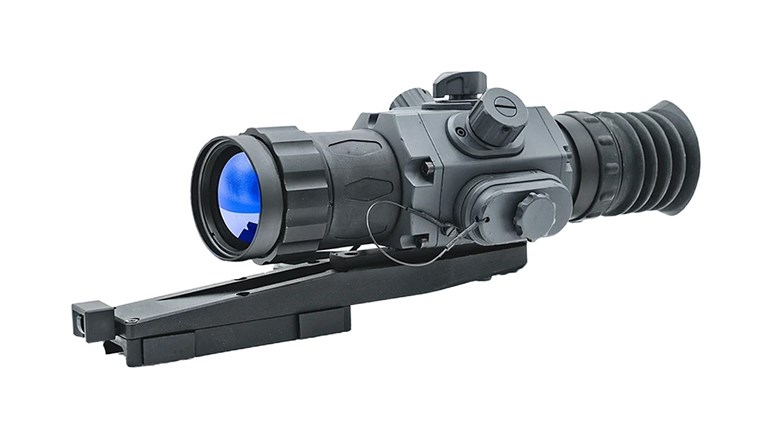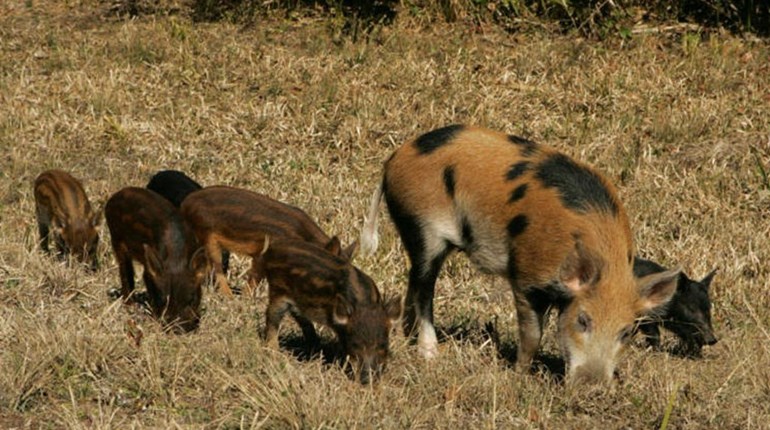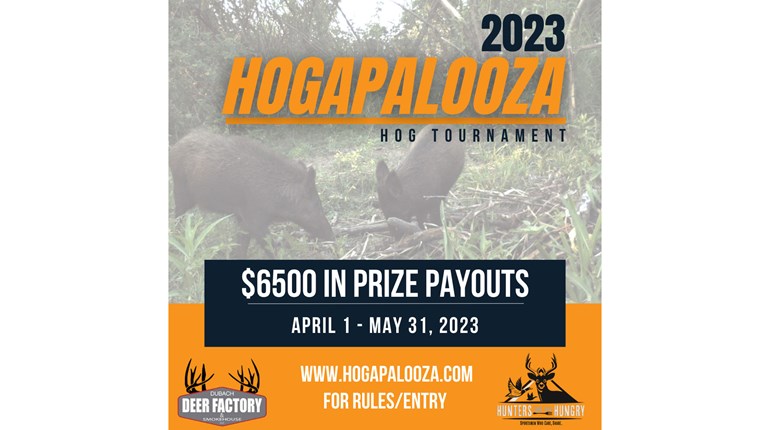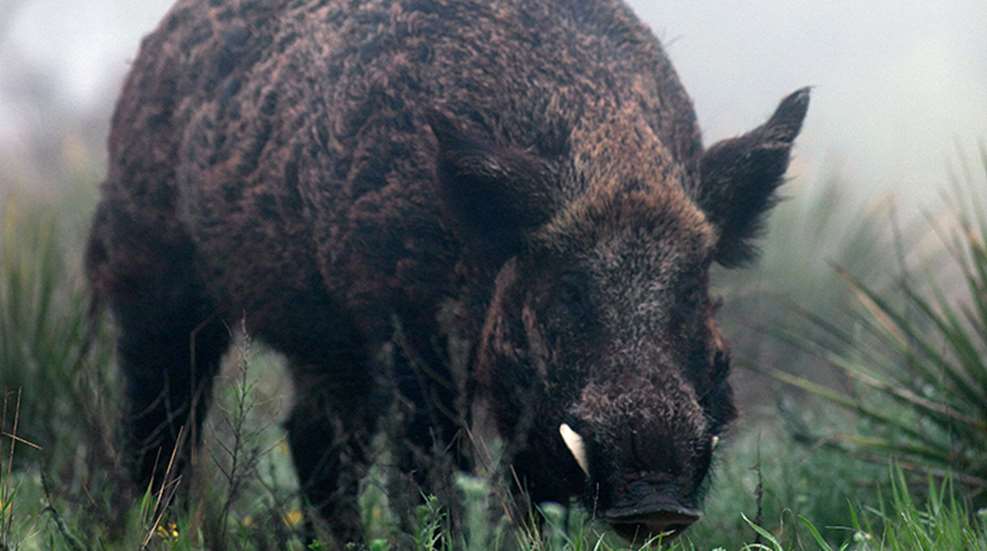
The landowner told us some pigs were bedding in his barley, a hanging field on a shelf above a deep arroyo. We made an impromptu drive and a big boar came out under my feet, a black mass pushing through green stalks like a torpedo, headed for the rim. Unable to see the ground—or my feet—I fell headlong twice as I ran after his wake, losing ground. At the edge of the ravine I set up on sticks, but it was even thicker below me. I couldn’t see anything in the bottom, but then tall weeds moved as he went up a cut on the far side. Vegetation thinned near the top and the black form came clear, moving slower now. Without much enthusiasm Chad Wiebe called, “300 yards.” I knew the rifle and got the crosshairs moving just ahead of the boar’s ear, and at the shot he was down so quickly I wasn’t sure what had happened.
Of many, that boar was the largest I’ve taken along California’s Central Coast. There was some luck in the shot, and more: On that day I was carrying a .300 Winchester Magnum. Usually I figure on getting close, so I don’t often carry a rifle practical at that distance—with or without luck. That sausage is just about gone, so I’m going “pigging” again next week, and I’ll carry a .45-70 … better not draw a shot like that!
Hogs in North America
About a hundred years ago, when I was first based in the old Petersen Publishing offices in Los Angeles, I quickly learned that California’s year-round hog hunting was one of the best things going. Anytime the concrete jungle started closing in we could head up the coast. That wasn’t my first experience with feral hogs. Dad and I hunted them in Tennessee when I was still a kid, and even back then you could occasionally pick up some pork on any Texas hunt. But in L.A. we got serious about them.
Sometimes we’d drive 500 miles north to the old Dye Creek Ranch below Mount Lassen. More often we’d meet at my house about midnight, usually Durwood Hollis and Payton Miller, and we’d drive through the night to the Central Coast and hike in the dark into some still-secret BLM ground. We hit about 50 percent on those public-land jaunts, not bad, but it was a terrible pack out with a pig so we sort of had a deal. If there were three of us we could shoot two, but if there were two of us we could only shoot one; then we had to divide the load onto our pack frames and head out. Once we invited one of our editors, a famous hunter. He looked down his nose and stated that he wasn’t “much of a pig hunter,” as if that was a lower life form. Seriously abashed, we went on our way and had a great pig hunt anyway.
Pigs are not native to the Western Hemisphere; the closest we have naturally are peccaries, what we call javelina. Though pig-like in appearance, they are only distantly related, with different dentition, different stomachs, different reproductive cycles, scent glands, and meat not nearly so tasty. But we do have pigs. Origins vary. On the West Coast and Florida domestic pigs were introduced by Spanish seafarers so passing ships could find fresh pork. Other feral populations started from settlers letting pigs roam free, and some show genuine Eurasian wild boar traits, introduced on purpose. None of these have remained pure; American wild pigs are feral hogs.
They have proliferated and expanded, in many areas to nuisance numbers, and they are an important part of American hunting culture today. This isn’t altogether new; in California, where I cut my pig-hunting teeth, wild hogs are a resource and a business. They have a season (year-round) and require licenses and tags (no bag limit, but each pig must be tagged), and years ago surpassed deer as the Golden State’s most popular big game. This is going to happen elsewhere. Hogs are prolific, intelligent, and when pressured become very nocturnal. They now range, discontinuously, from Mexico to southern Canada, with confirmed sightings in all 48 continental states.
Numbers are now estimated at 8 to 9 million, making the feral hog our second-most numerous big game after the whitetail—and pigs do some $2 billion in agricultural damage annually. For farmers they’re a curse … but for hunters they represent opportunity. My theory regarding hunting sociology is that hunters tend to hunt the game that is most available and accessible closest to home. In those years when I was in Los Angeles that game was wild hogs; today this is becoming reality for many North American hunters. There is no shame in being a “pig hunter.” Population control is essential, the meat is good, and pigs are exciting to hunt. Exponential growth of feral hogs in North America is recent, so many of us are just now learning this—but for many hunters throughout the world wild hogs have long been the most available and most accessible game. So, as we become “pig hunters,” we are joining a worldwide hunting culture.
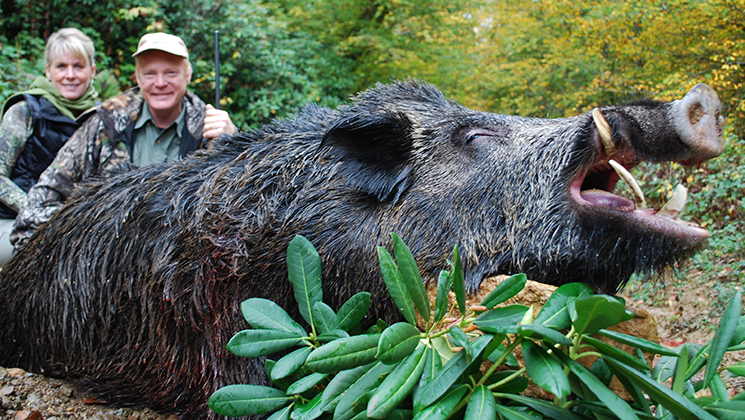
South America, South Pacific
In South America, feral hogs have much the same origin as ours. They are widely distributed in Argentina, the most widespread and numerous of the dozen-odd introduced species—and thus extremely important to local hunters. They are found well up into the Amazon Basin and in lots of other places we don’t hear about.
In the Pacific region, European seafarers introduced pigs to a lot of islands, as did Polynesian settlers. On smaller islands human activity, including hunting, seems to prevent overpopulation, but in sparsely populated (and huge) Australia some areas teem with feral hogs. Among Aussie hunters they are the most popular big game, but they are not plentiful everywhere. Hogs occur up in the water buffalo country of eastern Arnhem Land, but not in large numbers. There are some huge pigs up there, but sightings are infrequent. On the other hand, some of the best pig hunting I’ve ever seen was on a cattle station out of Katherine, in the southwestern portion of Northern Territories. Outfitter Bob Penfold had numerous baits set up, and it seemed that almost every one we checked had a big boar feeding.
Old World
This is home to the real deal, the Eurasian wild boar. I suppose that across this huge land mass there must be feral and mixed populations, but the Eurasian wild boar and the domestic pig are actually the same species, Sus scrofa. From what I’ve seen in North America, the genuine wild boar must possess a very dominant gene. Feral hogs come in all sorts of colors, but in areas where true Eurasian wild pigs were introduced the influence becomes quickly apparent—striped piglets, thick varicolored or “grizzled” coats on adults. So across most of Europe and Asia we figure there’s just one wild pig, the Eurasian wild boar.
In Western Europe wildlife is intensely managed, and is pretty much a cash crop to pay for that management. The true wild boar isn’t as prolific a breeder as the feral hog, but they reproduce quickly and are just as destructive of crops. A difference, however, is that the managers of hunting areas are often held responsible for the damage! So wild boars are hunted hard, and for local European hunters are often the most accessible and most available game. Some hunting, especially selective hunting for big boars, is done from stands, a lot of it at night in moonlight, preferably with snow. However, the organized drive is a favorite technique. The scale varies. In Germany I participated in a huge drive, 30-plus “guns” and more than 70 drivers with dogs and horns. In Estonia, I joined a small group of local hunters as they drove stands of timber—they told me they hunted this way just about every Saturday all through autumn.
Wherever pigs are found size varies with diet. Our Central California pigs have a hard time making a living, especially during our long, hot and dry summers. We figure a really big boar might weigh 250 pounds, and very few exceed 300. They get bigger in the Southeast, where food conditions are better. I am not convinced that Eurasian wild boars get bigger than feral hogs (in either body or tusk size), but in hard-hunted populations big, older boars are always a small minority. A big boar isn’t nearly as tasty as a medium-sized sow—but a big boar with good tusks is an awesome prize anywhere.
Turkey is the best place I ever hunted for big boars. This follows logically. Food sources are excellent, so the pigs get big. More importantly, however, Turkey is a Muslim country; most Turks don’t eat pork, and while Turkey has a strong hunting culture most folks leave pigs alone. The boars Donna and I shot there looked more like grizzly bears, huge with long coats, and tusks that, once pulled, were nearly 10 inches in length! That was a night hunt over bait, but pigs are also hunted by moonlight in croplands, and occasionally by drives.
The Eurasian wild boar is found all the way to Japan, but there are several other Asian pigs. Some, like the legendary babirusa with curling tusks, are not currently hunted, but a few others are here and there. In the Philippines I hunted both the Philippine bearded warty pig and feral hogs. Slightly smaller and more uniformly gray rather than dark, the pigs of the Indian subcontinent are somewhat different. An Indian wild boar eluded me on several hunts in Pakistan, and I didn’t get one in Nepal, either. Just recently, in farm country near the Indian border, I got a big boar in southern Pakistan. Cool!
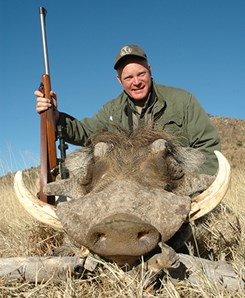 Africa
Africa
Africa has several varieties of wild pigs. Along the Mediterranean coast the most numerous large animal is the Barbary wild boar. Smaller and paler in color, it’s an offshoot of the Eurasian wild boar, separated for eons and legendary for its aggression. They’re hunted today in both Morocco and Tunisia, with shotguns only during well-organized drives. I hunted them in Tunisia, and it was really one of my best hunts ever. The pigs are surprisingly plentiful, and the Muslim farmers hate them; they’re delighted to see them thinned out!
Most widespread of the African swine is probably the bushpig. Nocturnal, cover-loving and difficult to hunt, bushpigs are found from South Africa to the Sahara, and on west through the forest zone. In Southern and East Africa bushpigs vary from tan to black, but off to the west they’re a uniform reddish color and are called “red river hogs.” Although South Africa hosts a huge diversity of antelope, much of its wildlife today is on private land and is a cash crop—sort of like Western Europe. Destructive of crops (sound familiar?), the bushpig is very available to local hunters who pursue them avidly, with dogs in daylight and over bait at night.
Often overlooked by visiting hunters, the bushpig is a great game animal. Years ago, when I was a lot younger, I hunted them with local hunters and their dogs. I’m pretty sure I ran a marathon that day, following hounds up and down cutlines in dense thorn. Late in the afternoon I crawled into that horrible Addo thorn and shot a big boar at about 10 feet. More recently I’ve hunted them over bait, also exciting but not quite as strenuous.
Bushpigs are found in most areas where there’s cover and water, but they’re so nocturnal that sightings are rare. In collective years of African hunting, I’ve seen bushpigs in daylight just a couple of times … with one exception: coastal Mozambique. There we often see them out feeding. Sightings are random enough that it’s almost impossible to hunt them on purpose, but in the course of a 10-day safari most hunters will have a chance.
Warthogs are almost as widely distributed, found from South Africa to the Sahara and also east to west—but not in the forest zone. The warthog is not a true pig; significant differences include the long antenna-like tail and dentition: The warthog’s major tusks are the uppers, curving out and up. Although males usually have larger tusks, sows can be toothy so at first it’s hard to tell them apart, but only the males have horizontal “warts” below the eyes. Nearly hairless, the warthog is sensitive to cold and is almost entirely diurnal; at night they’re usually snuggled in burrows, and are often seen feeding and going to water in the heat of the day.
This means that warthogs are highly visible and are usually plentiful so long as permanent water is available—but really big warthogs are scarce prizes. This is partly because warthogs are a favorite prey of the great cats, but also because, in Africa’s cycle of periodic drought, when water gets scarce the older males die first. I guess I really am a pig hunter because I’m hard-pressed to pass a good warthog … and no one will see a lot of big ones. The best place I ever saw for big warthogs was along the Aouk River in southern Chad. The locals there were Muslim and left them alone. It was the tail end of the dry season, the river dried to intermittent pools. At midday every pool had warthogs drinking, and there were some monsters.
Rarest of Africa’s hogs is the giant forest hog, one of Africa’s last large mammals to be identified to Western science. Plentiful nowhere, the giant forest hog is found throughout the forest zone and, discontinuously, in Kenya’s mountains and Ethiopia. The giant forest hog is a tall, leggy beast, generally not as heavy as the biggest Eurasian wild boar but taller, an imposing animal. Uniformly dark in color, the giant forest hog has warthog-like tusks, though shorter, and also has facial warts.
Nomadic and uncommon, in the huge forest zone it is almost impossible to hunt them on purpose. Over the course of eight safaris where giant forest hogs occur I’ve had exactly one chance. In eastern Central African Republic. Jacques Lemaux and I were looking for bongo tracks at a remote mineral lick when we found a puddle where forest hogs were wallowing. Jacques reckoned they would return daily until the water dried up. We could have built a machan and spent the next couple of days, but we were hunting bongo. So we checked that puddle at different times. On the third try we caught two and I shot a big male. That was my first forest safari and I didn’t get a bongo, but knowing what I know now, I’d have built the machan and waited for those forest hogs until hell froze over!












